What is the motivation to define a sensitivity of an analog voltmeter as ohm per voltage?
-
The ohms per volt gives a rough indication of the sensitivity and quality of a meter. A 10K/volt movement loads the circuit much more than a 20K/V. Huge selling point :-) – ChrisR Jan 28 '16 at 19:11
3 Answers

simulate this circuit – Schematic created using CircuitLab
Figure 1. DC voltmeter with range selector switch.
A simple DC voltmeter with range selector switches is shown in Figure 1.
- The meter movement will read full scale at 0.25 V and has a resistance of 5 kΩ. Adding 15 kΩ in series with the coil will convert the meter to 1 V full scale and the resistance will be 20 kΩ.
- For each successive range we need to increase the resistance proportionally at 20 kΩ per volt (difference per range select).
The Ω/V figure is taken into consideration to figure out how much the meter is loading / affecting the circuit being measured.
Digital meters tend to have fixed input impedance. Typically this is 10 MΩ and can be ignored in most applications where high accuracy is not required.
Figure 2. AVO 8 multimeter. Photo by Zureks on Wikipedia.
There are circuit schematics and some history for the AVO (amps, volts, ohms) meters on Richard's Radios and these are quite instructive and show some very clever circuits to maximise the utility of these instruments.
- 168,990
- 12
- 186
- 385
Because the meter movement has a full scale deflection at some specified current. A series resistor is used to turn it into a voltage measuring device. The value of this resistor will be V(for full scale) / I(full scale). So the impedance of the meter will be 1/(I full scale) ohms per volt (FSD).
- 8,749
- 4
- 36
- 58
- 1,885
- 10
- 9
-
i dont understand.. isnt "V(for full scale) / I(full scale)" is ohm? where does per volt come from? – user16307 Jan 28 '16 at 18:26
-
Yes that gives the number of ohms for the series resistor. But the value of the series resistor, as you can see from the expression is proportional to the value chosen for FS Volts. So for a given meter movement, the impedance on any voltage range will be a fixed number (1/I FSD) of ohms per volt. – user1582568 Jan 28 '16 at 18:30
-
Lets say the movement has 50uA FSD and I want a 10V range. I would have to use 10/50uA 200k resistor, or 20k per volt. If I want to make a 100V range with the same movement I use 100/50uA = 2Meg, still 20k/volt. – user1582568 Jan 28 '16 at 18:33
-
so the resistors are changing by keeping I(full scale) and the sensitivity the same? – user16307 Jan 28 '16 at 18:38
-
At full scale voltage, we need to have the full scale current flowing through the movement. In order to do that we must make the total resistance of the meter VFSD / I(FSD) so that V(FSD) across that resistance will give the correct current. If we want a higher voltage, we need a higher resistance to get the same current. – user1582568 Jan 28 '16 at 18:41
-
im wondering if fulls scale current same for each settings? thats what i understood to make the same deflection movement. is that right? – user16307 Jan 28 '16 at 18:44
-
Yes, the movement is like a tiny motor working against a spring. The full scale current is a fixed value so that is the current we need in whatever range the meter is set to. The lower the current of the movement the more sensitive the meter will be as we use larger value resistors. – user1582568 Jan 28 '16 at 18:47
From this wiki page
The sensitivity of such a meter can be expressed as "ohms per volt", the number of ohms resistance in the meter circuit divided by the full scale measured value. For example, a meter with a sensitivity of 1000 ohms per volt would draw 1 milliampere at full scale voltage; if the full scale was 200 volts, the resistance at the instrument's terminals would be 200,000 ohms and at full scale the meter would draw 1 milliampere from the circuit under test. For multi-range instruments, the input resistance varies as the instrument is switched to different ranges.
- 1,092
- 1
- 9
- 15
-
I discarded my answer after seeing the above posted, but the point is, an analog movement places a load on the device under test, which has to be accounted for. Digital meters usually have (for voltage) a fixed impedance in the 10's of megohms. – R Drast Jan 28 '16 at 18:22
-
